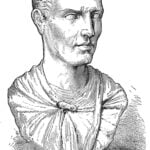Chapters
The Roman family was an institution sanctified by tradition and law. The Romans took pride in the strength of their families that had not faded over the centuries. The most important function of the family was to raise children in accordance with their welfare and social interest. However, the Roman family was legally different from the modern family. The main differences were: the existence of a very strong paternal authority, known as patria potestas, concluding an informal, private marriage certificate, as well as the recognition of legal equality between the father and children born of a rightful marriage, known as iustum matrimonium.
In Roman law, the family was a social union based on legal kinship. Father kinship was called paternal kinship (linea paterna), and maternal kinship (linea materna). Another relationship in the family was affinity (adfinitas), which was defined as the relationship that arose between one of the spouses and the spouse’s close cognitive relatives. Free persons who were members of the same family and had the same surname were called gentiles (gentiles).
Pater familias was the head of the house and a symbol of the endurance of the family. He had supreme power over free persons, related legal ties, and also slaves. People who were subordinate to him shared a social and political position with him, and after his death, they inherited his property and cult. The power of pater familias during the law of the XII tables was divided into: manus – power over the wife, patria potestas – over the children and dominica potestas – over the slaves.
The father of the family had many responsibilities toward his children. He had to provide them with an appropriate level of maintenance and education in accordance with good morals (bonae mores). Already at the end of the republic, the relationship between father and child called pietas began to take shape. It was about mutual, voluntary service and support. During the principate, the father’s tasks also included educating the child adequate to his birth and property, as well as instilling appropriate moral principles in him.
The content of the paternal authority
Pater Familias exercised his power for life and had many powers. They were primarily the right to life and death (ius vitae necisque), the right to abandon newborns (ius exponendi), the right to sell children (ius vendendi).
He had unlimited power over all persons and things within the family. He was even entitled to life and death (ius vitae necisque) over free family members. The law of life and death was an extremely extreme example of regulating family relations. At the beginning of the Roman state, the pater familias had the right to kill his children, for which he could face minimal sacred or censorship sanctions. During the principality, this right was limited. The law of life and death was abolished in the 4th century CE. In Justinian law, the father had only the right to discipline.
In exercising its right to discipline in disputes, pater familias had to take into account the decision of the domestic court (iudicium domesticum), which was composed of the closest relatives and neighbours. However, grave offences were brought under judicial authority.
On the other hand, the law of abandonment of newborns (ius exponendi) concerned mainly sick and weak children. The Act of XII tables ordered the death of failed fetuses. Newborn abandonment was also practised, which was not treated as a homicide. The sons and daughters born as the first child were not included in the law of abandonment. During the principate, mostly extra-marital children and female newborns were abandoned. Since the time of Diocletian, this law has been restricted. The introduction of Christianity contributed to the legal prohibition of these practices, although social tolerance continued until the fall of the Western Roman Empire in 476 CE Constantine the Great who took the abandoned child and treated it as his own, acquired the right of paternity over him.
Another law of pater familias was the right to sell children (ius vendendi), whereby he could sell his child even outside the Roman state (trans Tiberim), which was equivalent to enslavement. On the other hand, the sale of the child within the state borders led to the status of in mancipio, which was a temporary state, as the son returned to his father’s authority after liberation. After the third sale, the paternal authority would expire. The law of XII tables, however, limited the right to sell to no more than two people. Its total prohibition was introduced in 294 CE by Diocletian, however Constantine the Great in 329 CE allowed the sale of newborns in a situation of special poverty of the parents.
In addition to power over persons, with the extreme form of deciding their life and death, pater familias also had power over property. He was the sole owner, manager and administrator of the family’s property, and all purchases made by the children were transferred to his property. It was not a favourable situation for the economy, as the development of the property was slowing down, therefore efforts were made to keep the property in the hands of family members.
The methods of dividing property in ancient Rome were: peculium, peculium castrense, bona materna, bona adventicia.
Peculium consisted in separating individual elements from the family property (eg cattle, money, profit-making enterprises) and then transferring them to separate management. This method of separation was practised for sons and slaves, and less frequently for wives and daughters. Pater familias remained the owner of peculium and had the right to liquidate it. The son did not have the right to diminish the property, even if he exercised free administration over it, he only had the option of increasing it. The benefits were mutual – the father expanded the range of purchasing possibilities of the family, and the son used the family’s achievements and learned the rules of management, which was often the basis for legal emancipation.
The second way of allocating wealth was peculium castrense, meaning what the soldier was given by parents or relatives, or what was acquired during military service. This was to persuade people alieni iuris to perform professional military service, and during the dominion period, it was extended to acquisitions obtained in public, secular and clergy service. It was peculium “as if a camp (peculium quasi castrense), which was a separate property of the son and it was granted to the father if the father did not decide otherwise in his will before his death.
Later, the son was able to keep the property from his mother’s inheritance (bona materna), to which the father had limited rights. He was entitled to use the property unless it was stipulated that only his son could use it. The father did not have the right to sell or pledge this type of property.
The assets owned by the son did not necessarily have to come from the mother, but could also come from other sources (bona adventicia). The father’s powers were limited, he was left with the management board and temporary use without the possibility of disposing of. In the times of Justinian, only the father’s goods retained the “peculium” character. If the son died before his father, his bona adventicia inherited without a testament his closest heirs, but they were still managed by pater familias.
Ways to enter patria potestas
The simplest and most obvious way to enter a family, and thus under the authority of pater familias, was to be born into a legally recognized marriage. A son who was born into a full-fledged union was called iustus, that is, legal. Children born out of wedlock (liberi naturales, spurii, vulgo quaesiti) were not included in patria potestas. A child born out of wedlock born to a Roman woman was related only to the mother and her relatives and acquired the same social status as his mother at birth. The establishment of paternity was based on two main presumptions. The first concerned the principle that a child born in marriage comes from the mother’s husband: “The father is he who is indicated by the marriage”.
On the other hand, the second presumption was based on medical evidence which took into account the shortest and longest duration of pregnancy. The law stipulated that only a son born 182 days after the marriage and 300 days after its dissolution at the latest is legal. The father could have questioned his paternity, for example after being absent for several years.
One entered a Roman family not only by birth in iustum martrimonium, but also legally. The legal ways for pater familias to assume sovereignty over persons were adrogation (adrogatio) and adoption (adoptio).
And the road, that is, the adoption of sui iuris people consisted in the fact that the adrogated person passed to the adroit’s family along with all his property. Adrogated becoming a person alieni iuris losing all his property, therefore in this area there were numerous abuses, especially against orphans, half-orphans and young and inexperienced people. Adrogatio had to take place through public law, because thanks to this, the adoption was prepared more carefully, taking into account both adrogatio and adrogated laws. The college of pontificates gathered for adrogation took into account whether the adrogatio would not violate the norms of sacred law and whether the adrogated person would suffer damage from the adrogator. From the first century BCE, the adolescent took an oath, declaring that his intentions towards the adrogated were fair and right. The subsequent adoption procedure was the adrogation by the imperial edict (arrogatio per rescriptum principis), which was generally regulated in the post-classical period. From the time of Diocletian, with the special permission of the emperor, women who lost their own children could also be the ado.
In addition, it should be noted that the adrogated could not be the last male of the family (gens). In addition, the adolescent was required to have no children and no hope for children in the future, and an appropriate age difference – at least 18 years. The oath itself took place before comita curiata, and after its fall (and before the adrogation by the imperial rescript), before 30 lictors representing the Roman nation.
The second legal act thanks to which one came under the authority of pater familias was adoption. Through adoption, the person alieni iuris changed his family. For the adopted person, it was most advantageous that she did not change her legal situation. In Book II of the Rules, Modestin writes: “The sons of the family are created not only by nature, but also by adoption.” The adopted person was associated with the surname, family, agnation, tribus with the family to which he was admitted. In the Justinian period, the adoption procedure required the adoptive, adopted and his father to be brought before the court in order to prepare an appropriate document. At that time, two types of adoptions were distinguished:
- adoptio plena – performed by an adopted ascendant (initial relative, e.g. maternal grandfather); the adopted person passed under the authority of the adopter and his family;
- adoptio minus plena – leaving the adopted person under the authority of his natural father and granting the right to inherit from the adopter while maintaining the inheritance right in the current family. The adoption could have been made by a stranger (pater adoptivus extraneus).
- legitimatio per oblationem curiae – the status of a married child was granted to a son by entering him on the list of decurions. Daughters from cohabitation were also legitimized – by marriage with a decurion. Legimatio per oblationem curiae was introduced in the 5th century CE
The entire adoption procedure was much more complicated, especially when it came to adopting a son. Under the law regulated by the XII Tables Act the son only left his father’s patria potestas after selling three times. Only then was it possible to conduct an apparent debt collection process (in iure cessio), where the adopter declared to the praetor that he had patria potestas over the child, and the father of the family did not deny it. After the third sale, patria potestas expired. Proper adoption was followed by in iure cessio, which led to the acquisition of paternal authority with the participation of magistratus. The adopter declared to the praetor that the person was his child, and the opponent did not deny it and was followed by addictiomagistratus for the adopter. This procedure was simplified in the time of Justinian to the appropriate declaration of the adopting and adopting parents, included in the protocol. The necessary condition was the consent, even if tacit, by the person giving the adoption.
Sources indicate that there was a third way of gaining power, patria potestas, which was legitimacy. It consisted in accepting children born in cohabitation under its authority. One form was the marriage between the cohabitants (legitimatio per sequens matrimonium); the second – adoption through imperial rescript issued at the request of a natural father (legitimatio per rescriptum principis). Legitimatio was not created until the dominion period, where it was deliberately facilitated. On the other hand, in the Christian empire, attempts were made to persuade cohabitants to marry, because children born out of wedlock did not come under the father’s authority. From the time of Constantine the Great, children born in cohabitation were considered to be married after marriage by cohabitants.
End of paternal authority
The termination of paternal authority took place as a result of:
- death of pater familias or persons under his authority;
- capitis deminutio maxima (loss of freedom), media (loss of nationality) or minima; capitis deminutio minima (change of position in the family) took place through the adrogation of the father of the family, and on the part of those under his authority through adoptio, conventio in manum or emancipatio;
- obtaining by the child of the family priesthood or high state positions (praetorian prefect, city prefect, consul);
- gross abuses in the exercise of pater potestas, such as selling a family son, abandoning a descendant, making a daughter a prostitute or entering into an incestuous marriage;
- emancipation (emancipatio). This meant release from the power exercised by the pater familias who, however, had to voluntarily consent to it. This was a legal act by which the child (son, daughter) became sui iuris, which meant going beyond patria potestas. It was also connected with the shedding of agnatic kinship with the current family. At that time, only family ties remained (capitis deminutio minima).
Emancipation was the liberation from paternal authority as a result of which the child became a person sui iuris. Emancipation concerned the loss of paternal authority as a result of selling his son three times. Most often, however, the buyer resold his son to the father who liberated him but thus obtained the right of patronage. Daughters and grandchildren could only be sold once, and that was enough. In an earlier period, when the corresponding socio-economic changes had not yet taken place, emancipation meant disinheritance. Also, the father of the family could emancipate his sons in order to leave the property to one of them in order to prevent its fragmentation.







